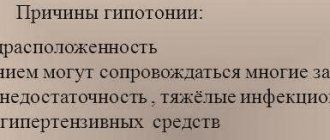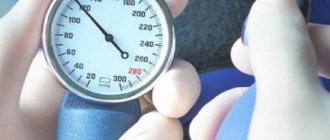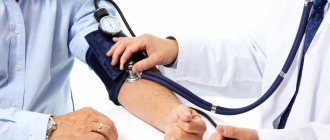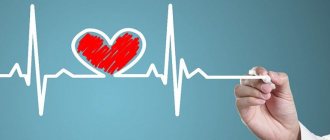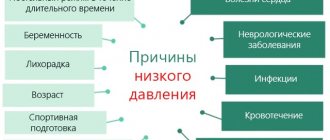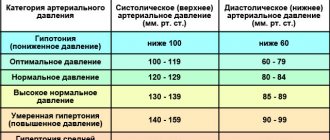25.11.2018
A.A.
(Last update: 10/05/2021)
There are contraindications. Specialist consultation required
Hypertension is a disease characterized by chronic high blood pressure. Hypertensive people are people whose blood pressure readings on a blood pressure monitor consistently exceed 140/90. In this state, blood circulation slows down, causing internal organs to suffer from hypoxia. The prolonged presence of hypertension not only impairs the functioning of all body systems, but can also cause life-threatening complications.
Many people believe that if blood pressure drops significantly in hypertensive patients, this is a clear sign of improvement in their condition. In fact, hypotension is even more dangerous for this group of people than for a healthy person. Indeed, in this case the body is subjected to enormous stress. Therefore, it is important to know how to behave in the event of a sharp decrease in blood pressure in a hypertensive patient.
What happens with hypertension
Indicators on the tonometer help determine the resistance of the elements of the circulatory system at the moment of tension and relaxation of the heart. The upper value is called systolic blood pressure, and the lower value is called diastolic blood pressure.
Do not self-medicate. Consult a specialist:
First degree hypertension is diagnosed if the blood pressure is above 140/90. If the indicators are above 160/100, then this is the second degree of the disease. Blood pressure of 180/110 and above is the third degree of chronic hypertension.
When pressure increases in the body, a number of specific changes occur. If we consider this process from a physical point of view, then narrowing and swelling of blood vessels occurs, blood circulation slows down, and the volume of the blood itself increases. This occurs as a result of many biochemical processes: angiotensin-2, aldosterone, adrenaline are intensively produced, bradykinin is actively degraded, and sodium retention occurs.
You get promotional code OZON - 300 points for your first order. OZONAPIE1I (applied in the cart)
With long-term hypertension, even with proper treatment, the body adapts to new conditions. Therefore, for hypertensive patients, ideal blood pressure values will be higher than for ordinary people. In this case, even a pressure of 110/70 is already considered low.
What it is?
This is the pressure that blood exerts on the walls of blood vessels, or, in other words, the excess of fluid pressure in the circulatory system over atmospheric pressure.
Blood pressure depends on three biological factors: the pulse, the degree to which the arteries are opened and flexible, and the amount of blood pumped through the vessels. Science knows that pressure deviations from the norm appear when the balance of substances affecting these three factors in the body is disturbed, but the exact picture of these disturbances is not yet clear.
The conventional norm of pressure is 120/80 mmHg or slightly lower. What we call “upper” pressure is systolic pressure, which is the pressure in the arteries at the moment when the heart contracts and pushes blood into the arteries. Systolic pressure depends on the strength of the heart's contraction.
The bottom number is diastolic blood pressure, which is the pressure in the arteries when the heart muscle relaxes. It reflects peripheral vascular resistance.
Both values are important, but for diagnosing patients over 50 years of age, systolic pressure is considered more indicative.
Deviations in blood pressure are hypotension, low blood pressure, and high blood pressure.
What happens if a hypertensive patient's blood pressure drops?
Low blood pressure for a hypertensive person is even more dangerous than hypotension for a healthy person. Indeed, in this case, the body, which has adapted to elevated blood pressure levels, experiences severe stress. Because of this, a number of negative phenomena arise.
What happens when a hypertensive patient’s blood pressure drops:
- The vessels dilate rapidly. Since in patients with hypertension, the elements of the circulatory system usually have reduced elasticity, this phenomenon can cause microtraumas on them.
- The heart, accustomed to working under conditions of high pressure, is forced to sharply adapt to the new situation. Because of this, the load on him increases significantly, which negatively affects his condition.
- In response to vasodilation throughout the body, blood vessels in the brain constrict. This threatens ischemia of this organ.
- When pressure decreases, the volume of fluid circulating throughout the body does not have time to increase. This also negatively affects the condition of the body.
- As a result of the above processes, hypoxia throughout the body increases. The likelihood of hemorrhages in internal organs also increases.
Such negative phenomena pose a serious threat to life. As a result of their exposure, a number of dangerous complications can develop.
Hypertension and low blood pressure
People who have crossed the forty-year mark of their age automatically fall into the risk group. But there are cases when this insidious disease affects very young people. Its causes are varied, but the main reason, that is, the root of the disease, is a person’s incorrect lifestyle and poor nutrition. It is generally accepted that a sign of hypertension is high blood pressure.
However, doctors say that this is not the main symptom, since often people come to them with an already diagnosed diagnosis, and their complaints are about low blood pressure. Why does this happen? Low blood pressure in hypertension can be explained by two factors. Firstly, this is the so-called physical inactivity. This happens when a person moves very little for one reason or another. With sustained physical inactivity, the body begins to restructure itself. During physical inactivity, less blood flows to the internal organs. The brain also receives less blood. In response to this, the brain sends a command to the vasomotor center to reduce the pressure.
The organism obeys the command of the main manager of the organism. The second factor is worn-out heart muscle. High blood pressure causes the heart to work harder. And the higher the pressure, the correspondingly greater the load on the heart muscle. When working hard, the heart, in simple terms, gets tired and stops working in the mode that the brain sets for it. The result is low blood pressure. What should you do if you are diagnosed with hypertension and your blood pressure drops? The first thing that must be done is to check the contractility of the heart. It can be detected by simply doing an ECG and echo of the heart.
If it shows normal contractility, then you should do regular physical exercise. Physical education will eliminate the symptoms of physical inactivity, and blood pressure will return to normal levels. You should start physical activity with the simplest physical exercises. They need to be performed a minimum number of times so as not to overtire the body. In this mode, physical training can be continued for several months.
If, during physical training, shortness of breath, discomfort in the heart area, and dizziness still appear, then the loads need to be reduced further. But there’s no point in stopping your classes! All these symptoms are a sign that the body is getting used to new conditions. Traditional medicine recipes can successfully help achieve average blood pressure levels during physical inactivity. Plants that alleviate physical inactivity include: radiola rosea, ginseng root, aralia root, eleutherococcus, thistle leaves. Also, the symptoms of physical inactivity are easily relieved by drinks such as coffee, tea with ginger. It should be noted that hypertension is incurable. This means that the presence of antihypertensive drugs in the first aid kit has not been canceled, even with persistent remission. Hypertensive patients should also know that antihypertensive drugs do not accumulate in the body and cannot be taken for future use. These drugs are completely eliminated from the body within two days. Long-term remission with a diagnosis of hypertension is very rare. It can only be observed in those people who have been ill recently and the disease is still diagnosed as the initial stage of hypertension.
The danger of low blood pressure in hypertensive patients
A decrease in blood pressure poses a great danger to hypertensive patients. In this condition, there is a high risk of developing dangerous complications. Many of them pose a threat to life.
What are the dangers of lowering blood pressure in hypertensive patients?
- With a sharp decrease in pressure, a rupture of the vessel is possible, accompanied by hemorrhage. The occurrence of such a problem in the brain is fraught with death.
- Development of heart failure. Since a sharp drop in blood pressure negatively affects the state of the pump in our body.
- Myocardial infarction is another negative consequence of a drop in blood pressure in a hypertensive patient.
- As a result of a sharp drop in blood pressure, ischemia may develop. This problem is especially likely to occur in older people.
- Cardiac arrest. This negative situation often causes death.
- Loss of consciousness. This increases the likelihood of injury from a fall.
- In pregnant women, a sharp drop in blood pressure from high to low levels can cause miscarriage. Also, this situation often leads to impaired fetal development.
When blood pressure drops in hypertensive patients, such dangerous complications can develop very quickly. Therefore, in this case, it is important to provide first aid correctly and in a timely manner.
With frequent surges in pressure, the negative impact on internal organs increases. This can lead to decreased brain activity, the development of kidney pathologies, heart disease and other dangerous problems.
Thus, for people suffering from hypertension, hypotension is very dangerous. This condition often leads to dangerous complications that pose a threat to life.
It is worth noting that the more advanced the degree of hypertension, the more dangerous the occurrence of hypotension. This is due to the fact that in this case it is more difficult for the body to adapt to new circumstances.
Reasons for the sharp decline
The variety of reasons for decreased blood pressure in a person with hypertension makes it difficult to determine it independently.
A sudden drop in blood pressure is a warning sign. There are several reasons for this change in hypertension:
- Heart failure. Violation of the pumping function of the heart is accompanied by a decrease in pressure in the blood vessels.
- Neurocirculatory dysfunction or VSD. Disturbances in the autonomic nervous system appear as a result of psycho-emotional stress. These conditions cannot be treated; rest helps relieve them.
- Kidney pathologies. Two hormones: adrenaline and acetylcholine control the tone of the vascular walls. They are produced by the adrenal glands. Adrenaline increases blood pressure and excites, acetylcholine lowers and depresses the general condition. Due to functional disorders of the adrenal glands, a jump occurs: blood pressure was high, and suddenly it became low.
- Intense bleeding. It is difficult to notice internal bleeding. The upper limit of blood pressure decreases significantly, the heart begins to beat faster. You can suspect a problem by severe pain in the upper abdomen.
- Medications. With drug treatment, a decrease in blood pressure is a side effect of certain medications (antibiotics, heart and pain medications).
- Infectious pathologies. Severe intoxication and an increase in body temperature provoke a decrease in blood pressure.
- Blood glucose level. Its decrease below normal provokes pathological abnormalities in the body.
- Depressed psychological state. Depression, which is accompanied by weight loss, indifference to everything, and lack of a sense of joy, serve as a source of changes in indicators.
Return to contents
Causes of hypotension in hypertensive patients
For hypertensive patients, a significant decrease in blood pressure is not specific. After all, even taking antihypertensive drugs in the later stages of the disease rarely reduces blood pressure to ideal levels. Hypotension in this case develops extremely rarely.
In order to successfully normalize the patient’s condition, it is necessary to identify why the hypertensive patient has low blood pressure. In fact, there is a fairly wide range of reasons for this situation.
Hypertensive patients may experience a decrease in blood pressure due to the development of certain diseases. Usually these are dangerous conditions or pathologies associated with emotional or hormonal imbalance.
The development of hypotension is possible under the influence of certain external factors. In most cases, these are negative influences that worsen the condition of the body. However, there are cases when the readings on the tonometer decrease under the influence of beneficial effects. However, in this case, the downward change in blood pressure will be smooth and asymptomatic.
When treating hypertension, a decrease in blood pressure may occur as a result of improper use of therapy. In this case, the problem will be associated with the negative effects of drugs. This situation is especially dangerous, since it increases the risk of dangerous situations developing significantly.
Pathological causes
There are a number of pathological reasons for low blood pressure in hypertensive patients. Such situations are especially dangerous, since in addition to the pressure surge itself, other pathologies affect the body.
Low blood pressure in hypertensive patients - causes associated with diseases:
- Internal bleeding. Heavy blood loss can occur as a result of injuries to internal organs, after surgical interventions, with ulcers in the stomach and intestines, with bleeding hemorrhoids and some other problems.
- A strong increase in pressure in the pulmonary elements of the circulatory system. This condition can be caused by heart attack, myocarditis, arrhythmia and cardiosclerosis.
- Cardiac type asthma. In this case, symptoms of suffocation, severe dry cough, and tachycardia occur. In this case, in a supine position, the symptoms worsen. Such patients are even forced to sleep while sitting.
- Pulmonary edema. This condition is accompanied by a wet cough with bloody foam, attacks of suffocation, severe tachycardia, as well as a significant increase in the veins in the neck.
- Poisoning. A significant decrease in blood pressure is especially common if this condition is accompanied by severe diarrhea and vomiting.
- Serious infectious diseases such as tuberculosis, sarcoidosis, etc.
- Viral and colds. Hypotension is most often observed if such diseases are accompanied by an increase in temperature.
- Acquired adrenal dysfunction. Blood pressure in hypertensive patients may decrease if the adrenal glands have been damaged due to various diseases or injuries.
- Vegetovascular dystonia. This condition refers to neurological disorders. It is accompanied by a decrease in pressure.
- Heart failure. With dysfunction of this organ, a decrease in pressure may be observed.
- Significant reduction in blood sugar levels. This effect can be achieved by combining certain antihypertensive drugs with antidiabetic agents.
Other reasons
In hypertensive patients, low blood pressure can occur not only due to the development of internal pathologies. Sometimes this problem occurs for reasons unrelated to any disease.
Why does blood pressure drop sharply in hypertensive patients?
- Sudden rise from bed after sleep. Some people, when taking an upright position after a long rest, may experience a short-term decrease in readings on the tonometer.
- Pregnancy. During this period, the readings on the tonometer are in most cases unstable. In addition, a decrease in blood pressure can also occur due to anemia, which is characteristic of most pregnant women.
- Incorrect use of antihypertensive drugs. This problem often occurs when patients take a dose that exceeds that prescribed by the doctor.
- Extended sports activities. Proper physical activity contributes to a gradual and steady decrease in blood pressure readings. Therefore, with regular exercise, there is a chance that a hypertensive patient’s blood pressure will drop to normal.
- Physical inactivity. Lack of movement negatively affects all body systems. As a result, this can lead to a sharp decrease in blood pressure even in hypertensive patients.
- Malnutrition. Strict diets in most cases lead to a sharp decrease in blood pressure. And for hypertensive patients, such a change can be critical.
- Lack of fluid. You can often hear that people suffering from hypertension need to drink little water. Such an error can lead to the development of dehydration, in which the pressure always drops.
Reasons for decreased blood pressure
The main reason for low blood pressure in hypertensive patients is considered to be drug overdose. Most often this occurs due to a lack of knowledge and taking medications without a doctor’s prescription.
Among the secondary reasons are:
- Diseases of the cardiovascular system (coronary heart disease, heart failure, endo- and myocarditis, pulmonary edema).
- Vegetative-vascular dystonia.
- Infectious diseases.
- Diseases of the kidneys and adrenal glands.
- Reduced blood sugar levels.
- Mental illnesses – depression, severe and prolonged stress.
- Taking antidepressants, analgesics.
- External and internal bleeding (perforated ulcer, hemorrhoids).
- Anaphylactic shock.
- Severe pain syndrome (attack of pancreatitis, renal colic, peptic ulcer, periodic pain in women).
Provoking factors
Not only the above conditions, but also a number of other provoking factors can lead to a decrease in blood pressure.
Common risk factors include:
- Prolonged bed rest.
- Pregnancy.
- Fever.
- Elderly age.
- Sedentary lifestyle.
- Orthostatic collapse when abruptly getting out of bed (especially in old age).
- Exposure to elevated temperatures that cause vasodilation (thermal springs, baths, saunas).
- Errors in nutrition.
- Prolonged exposure to the sun and tanning can cause blood pressure to drop. When tanning, adrenaline turns into the tanning hormone melanin and very little of it remains to maintain blood vessels in tone. Hence - weakness and hypotension after prolonged exposure to the sun.
A decrease in blood pressure due to hypertension always manifests itself with characteristic symptoms.
The most notable ones include:
- General weakness, lethargy, asthenia.
- State of depression.
- Headache.
- Nausea, vomiting.
- Darkening in the eyes.
- Dizziness.
- Possibly frequent loose stools.
Some symptoms are characteristic of both hypertensive and hypotensive crises. Therefore, you should pay attention to the totality of other manifestations.
| Hypotonic crisis | Hypertensive crisis |
| Skin | |
| The skin is pale, cold. Often - cold sticky sweat. Cold hands and feet. | The skin is pink and warm. The face is hyperemic. Extremities are warm. |
| Headache | |
| The pain is aching in nature, often diffuse. | The pain is pulsating in nature, often localized in the back of the head. |
| Heartbeat | |
| Weak, pulse is poorly defined. | Strong, often rapid. The pulse is frequent and well filled. |
| State of mind | |
| Depressed, increased sleepiness is noted. | Excited. |
| Other manifestations | |
| Nausea, single vomiting. Unsteady gait. Darkening in the eyes. Possible loss of consciousness. | Nausea, repeated vomiting, which does not bring relief. Flashing of flies before the eyes. |
A sharp decrease in blood pressure in a hypertensive patient is much more severe than in an ordinary person. And prolonged hypotension leads to negative changes in organs and tissues.
- Low blood pressure during pregnancy - what to do. Causes and products for high blood pressure in pregnant women
Depression and hypotension
A person’s blood pressure is greatly influenced by his psycho-emotional state. Stress is one of the main reasons for fluctuations in blood pressure monitor readings.
With depression, in most cases there is a strong decrease in blood pressure. However, indicators can fall even in a person who suffers from hypertension.
There are three types of depression, in which a significant decrease in blood pressure is observed. Each of them has certain symptoms.
Types of depression in which blood pressure may drop in a hypertensive patient:
- Asthenic depression. Accompanied by a strong feeling of fatigue. In most cases, with this disorder, the patient rapidly loses weight, to the point of severe exhaustion.
- Apathetic state. The patient loses interest in current events and the people around him. In this state, people lose interest in life.
- Anhedonic depression. This condition occurs when there is an excess of positive emotions. With it, the patient ceases to experience a feeling of joy.
Depression is no less dangerous than other pathological conditions. With them, there is a high probability of a sharp drop in blood pressure in a hypertensive patient, which is fraught with dangerous complications.
How is improper treatment of hypertension related to hypotension?
People with chronic hypertension may experience a drop in blood pressure if they do not use antihypertensive therapy correctly. There are several mistakes that patients most often make.
What mistakes should not be made when treating hypertension to prevent blood pressure from dropping:
- Taking antihypertensive drugs before measuring blood pressure. Some hypertensive patients may experience a decrease in blood pressure in the morning. If in this condition you additionally take an antihypertensive drug, the readings on the tonometer may become critically low. This is why doctors recommend measuring blood pressure in the morning and evening, before taking medications.
- Using large doses of the drug. In some cases, people take more medicine than the doctor prescribed, believing that this will increase the effectiveness of the therapy. Such an error can lead to a sharp drop in blood pressure and the development of a number of dangerous side effects. Some drugs in the first stages of treatment do not provide a sufficiently pronounced hypotensive effect, working in a cumulative manner. Therefore, it is not recommended to increase the dosage of the drug without the doctor’s permission.
- Inclusion of other medications in therapy without the doctor’s permission. Some drugs may enhance the effect of antihypertensive drugs. In this case, even taking the correct dose of medication can cause a sharp drop in blood pressure.
- Consumption of products incompatible with therapy. Some foods may also enhance the antihypertensive effect of drugs. For example, grapefruit juice increases the effect of calcium channel blockers by 70%. Therefore, this combination may cause overdose symptoms.
- Taking medications over a short period of time. Some antihypertensive drugs take a long time to be eliminated from the body. Therefore, if the patient takes a second dose ahead of time, an overdose may develop. This is why doctors recommend taking hypertension medicine at the same time every day.
What to do if a hypertensive patient has low blood pressure
Every person needs to know what to do if a hypertensive patient’s blood pressure drops sharply. After all, first aid skills will help save the victim’s life.
If there is a significant decrease in blood pressure in a hypertensive patient, first of all, it is necessary to call an ambulance. Before the specialist arrives, you need to provide first aid to the patient. And here, the main thing is to act quickly and correctly.
Low blood pressure with hypertension, what to do:
- The victim is laid on a flat surface, with his legs raised up. If the decrease in pressure occurs on the street, it is important to move the patient to the shade.
- All tight clothing is removed or unbuttoned. If the patient is indoors, the window must be opened slightly.
- It is necessary to cover the victim with a blanket or blanket.
- To improve the patient's condition, you can rub his earlobes. A light massage of the neck, shoulders and head is helpful.
- If a patient vomits, his head should be turned to the side.
- If the victim does not experience vomiting, breathing problems, or bloody foam at the mouth, then he can be given a cup of sweet, strong tea or coffee and a piece of dark chocolate.
What not to do when providing first aid
Incorrect first aid will only worsen the patient's condition. Therefore, below are several of the most common mistakes that people make when trying to normalize the condition of the victim.
Mistakes when providing first aid to a hypertensive patient with very low blood pressure:
- Alcohol consumption. If you have low blood pressure, you should not offer alcohol to hypertensive patients. This can help further relax the blood vessels and reduce pressure.
- Applying ammonia to the nose. This technique can worsen the condition and even cause suffocation.
- Using cold compresses. Often, with hypotension in hypertensive patients, vasoconstriction occurs in the head. If you apply cold compresses to your face or pour water on it, the situation may worsen.
- Use medications to increase blood pressure without your doctor's permission. The patient may have contraindications to such drugs.
At the doctor
After the ambulance arrives, the victim is hospitalized. Doctors normalize his condition, and then find out the reason for the sharp drop in blood pressure.
To help doctors normalize the patient’s condition, you need to prepare answers to several questions before their arrival. You should try to find them out from the victim.
What questions will the doctor ask:
- Age of the victim;
- Pressure indicators;
- What medications were taken during the day;
- Presence of chronic diseases;
- What symptoms does the victim have?
After normalization of the patient’s condition, the patient will be sent for examination to determine the cause of the current situation. Among the most common diagnostic methods: ultrasound, MRI and CT of internal organs, blood and urine tests for biochemistry, ECG and EchoCG. Vascular monitoring may be required.
Next, the patient may be referred to more specialized specialists. Typically, assistance from a cardiologist, endocrinologist, nephrologist, urologist, immunologist or infectious disease specialist is required.
After a drop in blood pressure, hypertensive patients undergo long-term rehabilitation. They may even need to change their previously used antihypertensive therapy. It is especially important for such people to regularly measure their blood pressure before taking medications.
Low blood pressure - what is the danger?
Photo from everydayhealth.com
Hypotension is diagnosed when blood pressure is 90/60 or lower. As a rule, stable low blood pressure does not pose a danger to the body and most often does not particularly affect a person’s well-being.
Serious consequences can be caused by a sharp drop in pressure, the causes of which are blood loss, low body temperature, elevated body temperature, sepsis, dehydration as a result of vomiting or diarrhea, a reaction to medication or alcohol, or anaphylactic shock. In all these cases, the patient needs emergency medical care.
There is also a diagnosis such as orthostatic (postural) hypotension. This is a sharp drop in blood pressure when the patient takes an upright position. Fainting, loss and confusion, dizziness, and blurred vision may occur within a few seconds or over a longer period.
This is a manifestation of abnormal regulation of blood pressure, due to various reasons, and not a separate disease.
Orthostatic hypotension occurs in 20% of older people. More often, it can be present in people with concomitant diseases, mainly arterial hypertension, and then the patient complains that the pressure is “jumping.”
In this case, you should definitely consult a doctor, who should adjust medication prescriptions if the patient was taking medications for high blood pressure, diuretics or psychotropic drugs.
If you constantly experience symptoms of low blood pressure, and measurements give readings of 90/60 or lower, then there is a danger that your organs are not receiving enough oxygen, which in turn can lead to dysfunction of the heart and brain.
These are the symptoms:
- Dizziness; – Feeling of lightness in the head; – Loss of body balance; - Weakness; – Fatigue; - Nausea; – Paleness; – Sweat on the skin; - Fainting.
What medications can you take?
Hypertensive patients can use blood pressure medications only with the permission of a doctor. Indeed, in this case, you need to use hypertensive drugs especially carefully.
There are several types of medications that can increase blood pressure. Each of them has its own contraindications.
Means for lowering pressure:
- Adrenergic agonists. Drugs that promote vasoconstriction. These include Norepinephrine.
- Anticholinergics. They also have a vasoconstrictor effect.
- Adaptogens. Normalize the functioning of the cardiovascular system.
- Drugs that stimulate the nervous system.
Some interesting facts about hypertension
Photo from mopani.co.za
American scientists have found that women who breastfeed their babies for 12 months or longer reduce their risk of developing hypertension in the next 14 years.
Those who have not yet become hypertensive, but observe from time to time an increase in their upper pressure to 130-140, are recommended to eat raisins. Most likely, raisins help keep blood pressure normal due to their high potassium content, which has a beneficial effect on the cardiovascular system as a whole.
But here is an interesting article about how the most common yellow garden peas can improve the condition of high blood pressure and kidney failure.
Folk remedies
There are a number of folk remedies that will help quickly raise blood pressure. At home, their use is safer than the use of hypertensive drugs.
Folk remedies for increasing blood pressure:
- Strong coffee with sugar. You can supplement the tonic drink with a piece of dark chocolate. Products with sugar can be used if the patient does not suffer from diabetes.
- Hot black and green sweet tea. In this case, you can only use hot drinks, since cold ones can have the opposite effect.
- A mixture of honey and cinnamon. For a tablespoon of honey you need to take a pinch of aromatic spice. This remedy is washed down with hot black tea with lemon. Diabetics can also afford a little honey (with a decompensated form there are additional restrictions).
- Tinctures of ginseng, aralia and Chinese lemongrass. This product should be taken in accordance with the instructions for use.
- St. John's wort decoction. This drug reduces the effect of calcium channel blockers.
- Aromatherapy with sage, rosemary and mint.
- Neck and head massage. It is carried out by pressing the fingertips from the neck to the head.
How to behave in such a case?
It is necessary to maximize the blood supply to vital organs. To do this, you need to extract the blood volume deposited in the vessels of the extremities and move it to the central parts of the human body.
If the symptoms of hypotension are pronounced, it is necessary to call an ambulance, and before it arrives, alleviate the condition of the victim on your own.
Tactics at home and with improvised means
| Action | The essence | Mechanism of influence on blood pressure |
| Place the victim in the correct position | The person is placed on his back, his straight legs are raised 20-30 cm above the ground. You can put a cushion or folded clothes under them. The fixator can be the knees of the person providing assistance. | Redistribution of blood from peripheral vessels to the central parts of the bloodstream |
| Remove reason | Do not take antihypertensive drugs, restore water balance if dehydrated | Leveling the effect of the pathological factor |
| Let me drink if my condition allows. | You can drink strong tea, coffee or plain water | The fluid deficit in the body is restored, and invigorating drinks activate the sympathetic part of the nervous system (which is responsible for increasing blood pressure) |
| Taking medications | Alpha adrenergic agonists | Stimulation of vascular tone and cardiac muscle activity |
| Anticholinergics | Blocking the influence of the parasympathetic part of the autonomic nervous system (responsible for lowering blood pressure) |
First aid algorithm, or what an ambulance does upon arrival
- Placing a person with hypotension in a horizontal plane with the lower end of the body elevated (the pelvis and legs are positioned above the head, this is called the Trendelenburg anti-shock position).
Catheterization of a peripheral vein (two if the condition is unstable).- Removing the cause that caused hypotension (if possible).
- Infusion (infusion) of saline solution or other drug capable of filling the volume of the vascular bed. This will raise blood pressure and help prevent the development of shock due to hypotension.
- Administration of drugs that constrict blood vessels (adrenergic agonists: adrenaline, mezaton).
- Stimulation of cardiac activity (dopamine, dobutamine).
Lifestyle and nutrition
With hypertension, it is very important to be careful about your lifestyle and diet. This will help avoid a sharp drop in pressure.
Lifestyle with hypertension:
- Increase your activity. Physical inactivity can lead to a decrease in blood pressure even in hypertensive patients. Therefore, in this case it is especially important to exercise. People with the first and second degrees of the disease can attend yoga, swimming pool, fitness, dancing, etc. In the third stage of the disease, you can use breathing exercises or specially designed exercises.
- Normalize your daily routine. The patient needs to go to bed early and get up early. You need to sleep at least 8 hours a day.
- Fresh air. It is important for hypertensive patients to take leisurely walks in the fresh air every day.
- Cold and hot shower. Such morning procedures will help normalize blood pressure throughout the day.
- Exercising in bed. Before getting out of bed after sleep, you need to do a 10-minute warm-up while lying down.
- Regular blood pressure measurements. Before taking medications, hypertensive patients must have their blood pressure measured.
- Optimal amount of liquid. Hypertensive patients should not drink a lot of water, but lack of fluid can lead to serious complications. Therefore, such people need to drink at least 1.5 liters of water per day, or a more optimal amount for them, calculated by the formula: 30 ml x weight in kilograms.
- Proper nutrition. People with blood pressure problems need to consume a minimal amount of salt. It is important to give up fatty, smoked, spicy and pickled foods and alcohol. It is necessary to give preference to fresh vegetables and fruits, as well as foods rich in vitamins and minerals.
- Inner harmony. It is very important to avoid stress if you have hypertension. The practice of yoga will help with this. It combines both physical and spiritual stress.
A drop in blood pressure in a hypertensive patient poses a threat to his life. In such a situation, it is necessary to immediately call an ambulance and provide first aid to the victim. Self-treatment in this condition is contraindicated. Listen to your body's signals, lead a healthy lifestyle and be healthy!
